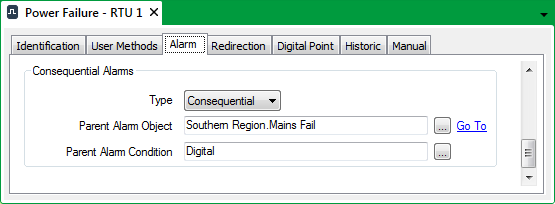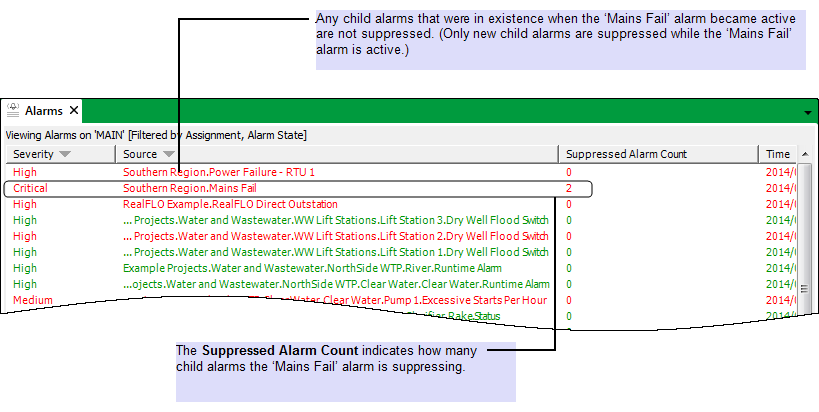This example demonstrates how ClearSCADA might be configured to suppress the alarms of three database items, depending on the alarm status of a fourth item. The example demonstrates the effects of alarm suppression on those database items.
Example:
A ClearSCADA database includes a ‘Mains Fail’ item, which indicates whether a particular area is experiencing a mains power outage. In addition, the database includes individual ‘Power Failure’ items for each outstation (RTU).
If the power to an individual outstation is lost, the relevant ‘Power Failure’ alarm is raised.
If the power outage applies to a whole area, that area’s ‘Mains Fail’ alarm is raised. Additionally, a ‘Power Failure’ alarm is raised on each outstation in that area. Without alarm suppression, this would result in operators being faced with a number of new alarms being raised, each as a consequence of the same power outage. Therefore, alarm suppression is used to:
- Help ensure that the cause of the alarms is not masked by the appearance of numerous ‘Power Failure’ alarms (which might otherwise suggest that the power local to several outstations is down, rather than the power to the whole area)
- Avoid the need to respond to and/or acknowledge numerous alarms that have each been raised as a consequence of the same incident (in this case, mains power outage).
The alarm suppression is used to suppress (omit from any alarm displays) any ‘child alarms’ (in this case, any outstation alarms, including ‘Power Failure’ alarms) that are raised once the mains power outage has been detected in the area in which the outstations are located. The suppression remains in force for as long as the mains power outage continues. The alarm suppression works by suppressing any new alarms on each outstation in that particular area, while that area’s ‘Mains Fail’ alarm is raised. (Alarms are not suppressed if the power outage is local to only one or some of the outstations in the area.)
To suppress the individual ‘Power Failure’ alarms, the ‘Mains Fail’ database item is assigned as each ‘Power Failure’ item’s Parent Alarm Object:

Should the ‘Mains Fail’ alarm become active, the individual ‘Power Failure’ alarms that are triggered as a result of the mains power outage are suppressed (not shown on any alarm displays).
The Suppressed Alarm Count for the ‘Mains Fail’ alarm indicates how many alarms are suppressed:

The ‘Mains Fail’ item’s Suppressed Alarm Objects pick action is used to display a list of the child database items that might have suppressed alarms due to the ‘Mains Fail’ alarm being active:

Further Information